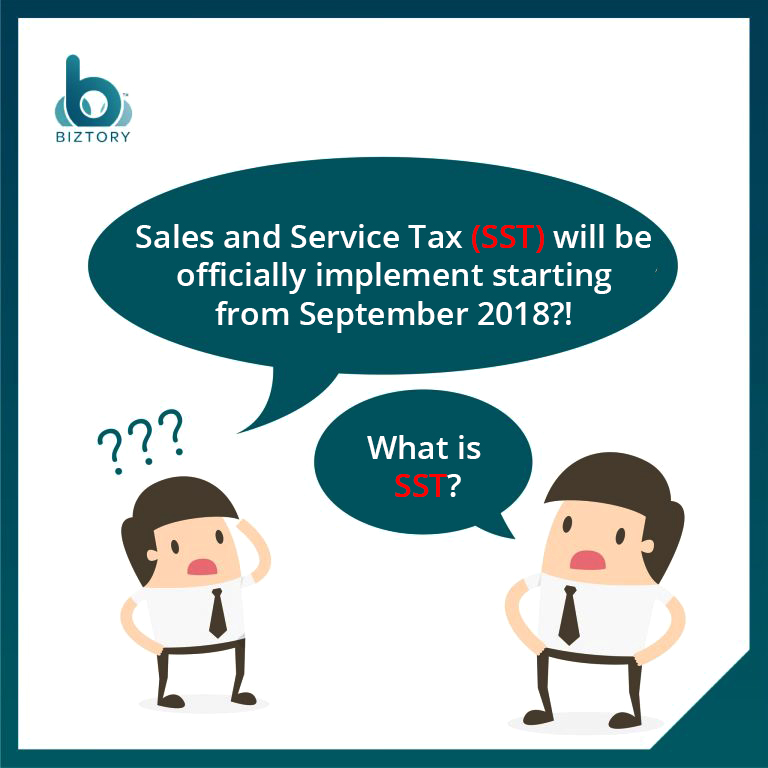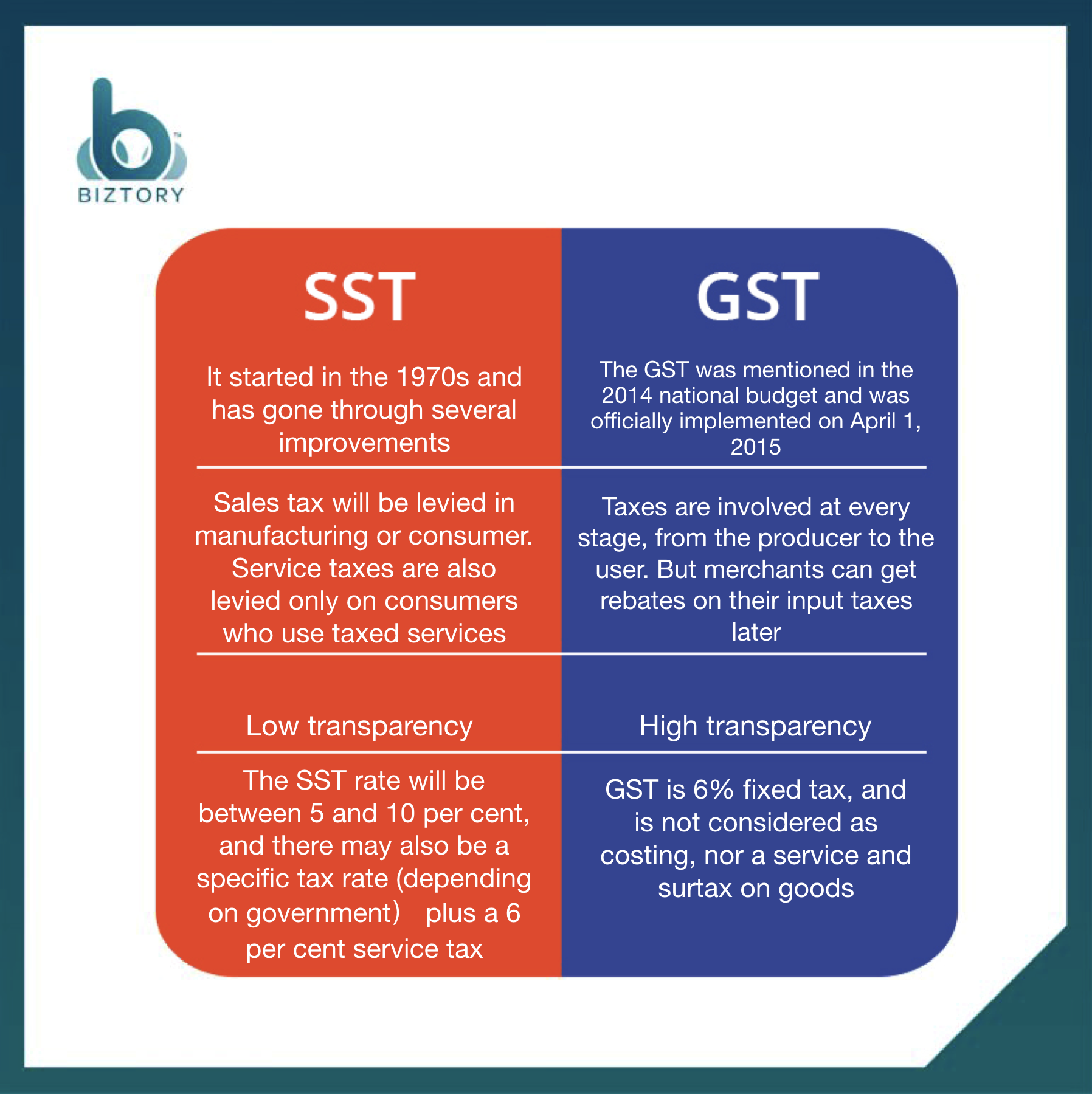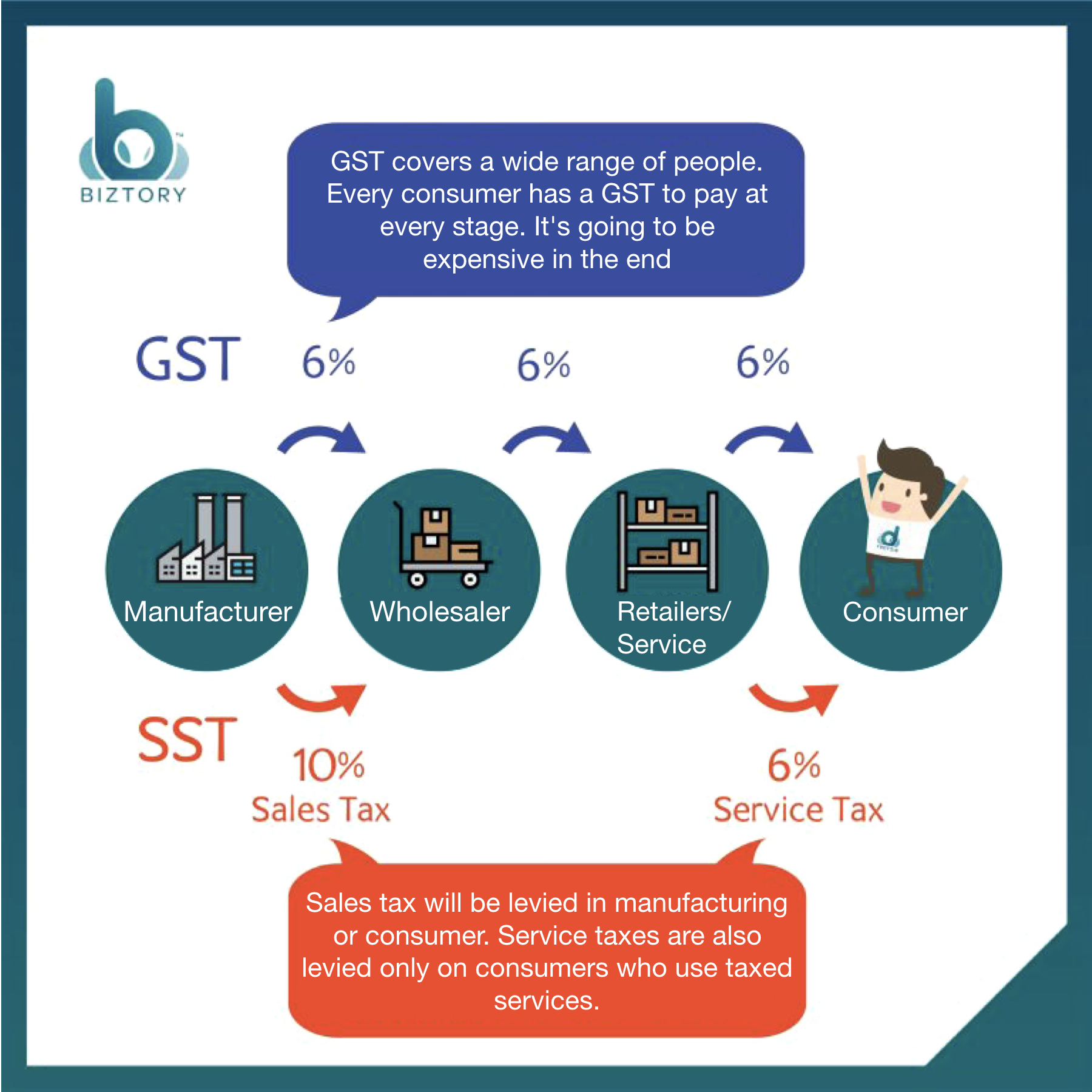Contents
- What is SST?
- What is GST?
- Differences between SST and GST
- What is the significant change to us as Malaysians from this change of the tax laws?
- What will happen to the prices in the market?
- What is the impact of the change of GST to SST in Malaysia?
- Conclusion
- Finding a way to free from the accounting taxation problem?

After the 2018 election, while GST decreased to 0 per cent, the government have also announced Sales & Service Tax (SST) will be officially implemented in September this year. So, they are both taxes, what are the most important differences between GST and SST for consumers?
SST is said to be less burdensome, how is that not burdensome, and in what form is it collected in comparison with GST? Before you know the difference, look at the following chart to build a basic understanding of SST and GST.
What is SST?
SST refers to Sales and Service Tax. The sales tax is only levied on the level of the producer or manufacturer, while the service tax is imposed on all customers who use tax services. The SST rates are less transparent than the standard 6% GST, the SST rates vary between 6 and 10%.
What is GST?
GST is a multi-level tax system for most businesses and industries, including manufacturers, distributors, retailers and consumers. GST covers a wide range of targets, from manufacturers selling products to dealers, reselling them to retailers, and then reselling them to consumers at every stage.
GST comprises all businesses, retailers and trades. The sales tax covers only manufacturers whereas the service tax covers certain prescribed services such as professional services. The suppliers are allowed to claim back the government’s GST, but the government does not immediately refund the GST claims, which creates problems for the cash flow of the companies.
While SST is a single tax system, only the service industry and manufacturers need to pay SST when selling products to dealers. SST has only one phase to pay taxes, compared with every phase of GST.
Differences between SST and GST
| SST | GST |
| Multi-stage tax | Single-stage tax |
| It started in the 1970s and has gone through several improvements | The GST was mentioned in the 2014 national budget and was officially implemented on April 1, 2015 |
| Sales tax will be levied in manufacturing or consumer. Service taxes are also levied only on consumers who use taxed services. | Taxes are involved at every stage, from the producer to the user. But merchants can get rebates on their input taxes later. |
| Low transparency | High transparency |
| The SST rate will be between 5 and 10 per cent, and there may also be a specific tax rate (depending on government) plus a 6 per cent service tax. | GST is 6 per cent fixed tax, and is not considered as costing, nor service and surtax on goods. |
| Mandatory registration upon reaching a threshold of RM500,000 (voluntary registration is also possible). |
● Sales Tax: A license had to be obtained if annual sales turnover exceeded RM100,000* ● Service Tax: A range of registration thresholds from 0 to RM3mil* |
| Input tax can be offset against output tax | No tax credit mechanism |
| Returns filed either monthly, bi-monthly or quarterly (with the option to request an alternative filing period) | Returns filed on a bi-monthly basis |
The above differences are about the basic differences between GST and SST, which is also the fundamental reason why people of our country opposed the implementation of GST in the first place. Before the SST is officially implemented, take time to enjoy the ‘honeymoon period’ of spending money in Malaysia.
Each layer of the supply chain from the supplier, the manufacturer, the retailer to the customer, must pay 6 per cent GST in addition to other charges. This may have forced businesses to increase their rates, which explains the high cost of products during the implementation of GST.
As for SST, the 10 per cent sales tax is imposed only on the level of the manufacturer, while the 6 per cent service tax will be charged by businesses to consumers, mostly in the hospitality industry like hotels, restaurants, pubs, and spas, under license from the Customs Department. It may also be paid by a specialist (or advisory services) such as an accountant or a lawyer.


GST is a multi-level tax system for most businesses and industries, including manufacturers, distributors, retailers and consumers. GST covers a wide range, from manufacturers selling products to dealers, reselling them to retailers, and then reselling them to consumers at every stage. ; While SST is a single tax system, only the service industry and manufacturers need to pay SST when selling products to dealers. SST has only one phase to pay taxes, compared with every phase of GST.
Differences (2) threshold
While both GST and SST require registration for a turnover of more than 500,000, SST does not include any buying or selling of a home or property, and GST is included. For the average person, buying a house is hard enough, plus a 6% excise tax, to make it harder to buy a house. In addition, SST involves a narrow level, and most of the daily supplies do not involve SST. However, GST covers a wide range of aspects, and a lot of things will be levied on GST. According to official information, when SST comes into effect, all GST registered companies will automatically default to SST registered merchants and turn in every 2 months. So merchants do not need to adapt to the new system again, nor do they need to register again.
The above two differences are about the basic differences between GST and SST, which is also the fundamental reason why people of our country opposed the implementation of GST in the first place. Before the SST is officially implemented, take time to enjoy the ‘honeymoon period’ of spending money in Malaysia.
What is the significant change to us as Malaysians from this change of the tax laws?
While both GST and SST require registration for a turnover of more than 500,000, SST does not include any buying or selling of a home or property while GST is included. For an average person, buying a house is hard enough, plus a 6 per cent excise tax makes it harder to buy a house.
In addition, SST involves a narrow level, and most of the daily supplies do not involve SST. GST covers a wide range of aspects, and a lot of things will be levied on GST. According to official information, when SST comes into effect, all GST registered companies will automatically default to SST registered merchants and turn in every 2 months. So merchants do not need to adapt to the new system again, nor do they need to register again.
Here are some of the significance of SST to you might want to know:
- SST is a single-stage tax which means that it is levied only once during the entire supply chain, either at the time of manufacture or at the time of importation into Malaysia
- The cost of living will probably fall, consumption will increase and companies will be able to sell their products at competitive prices
- Under this new indirect tax system, there are a lot of exempted goods included like food products, chemicals, medicinal goods, medicine, iron, steel and machinery. This means that a limited number of companies have to comply with SST and file under it.
- Tax on goods and services will be changed to mitigate its effect on lower-income classes
- Imported and exported services are non-taxable under Malaysia SST
What will happen to the prices in the market?
It is said that any business entity is driven by the maximisation of profit. Therefore, there is a possibility for businesses to abuse the reimplementation of SST. It comes to a few questions when it comes to whether the prices of goods will drop or increase:
- How many levels are there in the product supply chain between the manufacturer and consumer
- Different products and services are affected differently, for example, reloadable cards, cars, mobile phones and food items
- Prevailing tax exemptions for businesses
Previously, there have been a lot of hearsays about how prices could fluctuate after SST replaced GST ever since the announcement was released. Some of the Malaysians expect consumer prices to drop while others think otherwise.
Malaysians may expect specific adjustment of prices depending on the type of products or services that are being paid for. The customs department released a draft list of products exempted from sales tax.
What is the impact of the change of GST to SST in Malaysia?
SST will usually see lower retail rates, but there may be a possible increase in certain products, including the costs or charges for the services provided. Sales tax is based on the cost of producing or importing products, so whether it is imposed on the previous tax rate of up to 10% the prices of goods will decrease.
Below are the two impacts you can expect to go through:
- Prices to increase
- Car prices are expected to rise by about 2-3% above the GST price. That depends on demand, and they are also possibilities for auto players to absorb the cost.
- If the government retains the same previously used SST program, the overall tax burden would increase from 0% to about 10% on groceries, household and car-related items.
- Prices to decrease
- Prices of retail shops for clothing, cosmetics, and gadgets will be slightly lower around 3% from input cost savings.
- Houses are expected to experience a marginally lower price due to the lower cost of inputs.
Conclusion
Replacing GST with SST is expected to generate more disposable revenue, which will boost consumer spending and business activities. Suitable disposable income would also promote private spending and business development.
You can expect the opportunities for non-compliance and profiteering to exist during this period of tax system change. Since prices are declining, a lot of monitoring and enforcement operations will have the chance to perform productively.
Finding a way to free from the accounting taxation problem?
Biztory
Tired of having all the calculations done by your accountant? Want to spend less and save more of your cost? You can now simply learn how to do it yourself! If you are a business owner, we suggest you try out Biztory, a cloud accounting software specifically made for business owners to navigate the software without any hassle.
With this smart business assistant, you can manage their tasks in billing, inventory, and tax estimation & submissions, while monitoring business performance through summarised reports and analytics generated in real time.
At the same time, any problems that you might have faced while doing bookkeeping before can be solved easily. You don’t have to go through the trouble of sending your invoices, statements, and receipts to your accountant for all your transactions.
Alternatively, with Biztory, simply by generating an invoice online, you get to avoid going through manual bookkeeping, which is difficult to manage if you are not an accountant.
